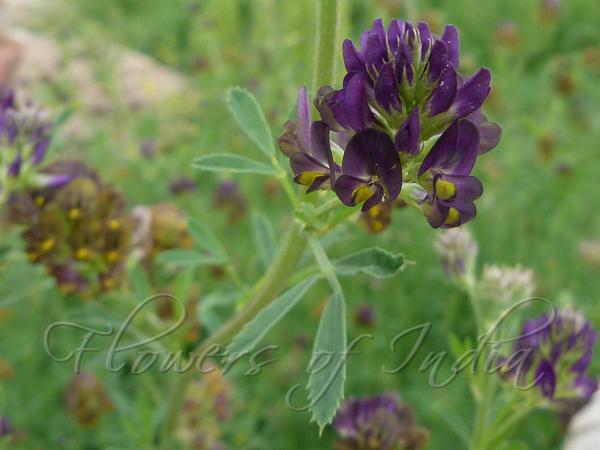|
| Alfalfa |
|

|

| File size | 212061 |
| Original date | 6/25/12 4:39 PM |
| Resolution | 2560 x 1920 |
| Flash | Flash did not fire, auto |
| Focal length | 4.5mm |
| Exposure time | 1/100s |
| Aperture | 3.6 |
| Focus Distance | |
| Metering Mode | Multi-segment |
| Camera make | Panasonic |
| Camera model | DMC-FZ40 |
| Sensor type | OneChipColorArea |
|
|
|
|
Photo: |
Botanical name: Medicago sativa Family: Fabaceae (Pea family)
Alfalfa is a perennial herb with stems erect or sometimes prostrate, 0.3–1
m long, 5-25 or more per crown, much-branched, 4-angled. Rhizome is stout,
penetrating the soil as much as 7-9 m. Stipules are united up to 1/3-1/2
of the length - free portion is triangular-lanceshaped, tapering, basally
entire or with 1–2 teeth. Leaves are trifoliolate - leaflets are obovate-
oblong, ovate or linear, tapering to base, toothed above middle, 1-4.5 cm
long, 3–10 mm broad, smooth or appressed hairy, paler green beneath.
Flower racemes are oval or rounded, 1-2.5 cm long, 1-2 cm broad, arising
in leaf axils, 5-40-flowered. Stalk carrying the cluster is slender, firm,
always exceeding the subtending leaf. Sepal cup is tubular, with linear-
subulate teeth longer then tube. Flowers are yellow or blue to purple or
violet, 6-15 mm long.
Pod is 3-9 mm in diameter, with 2-3 spirals,
prominently net-veined. Seeds are 6 or 8 per pod. Alfalfa is widely grown
throughout the world as forage for cattle, and is most often harvested as
hay. Alfalfa has the highest feeding value of all common hay crops,
being used less frequently as pasture. Flowering: May-July.
| Identification credit: Gurcharan Singh | Photographed in Leh, Ladakh. |
• Is this flower misidentified? If yes,